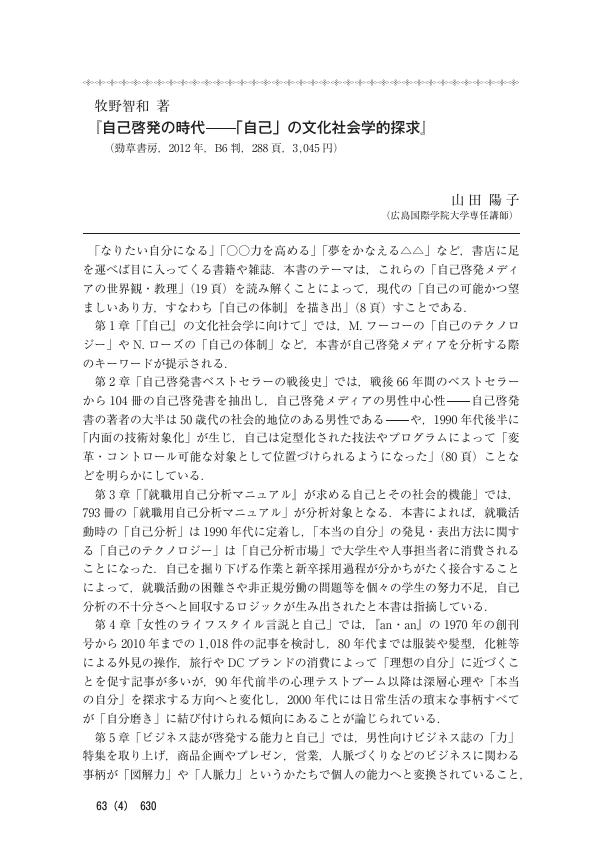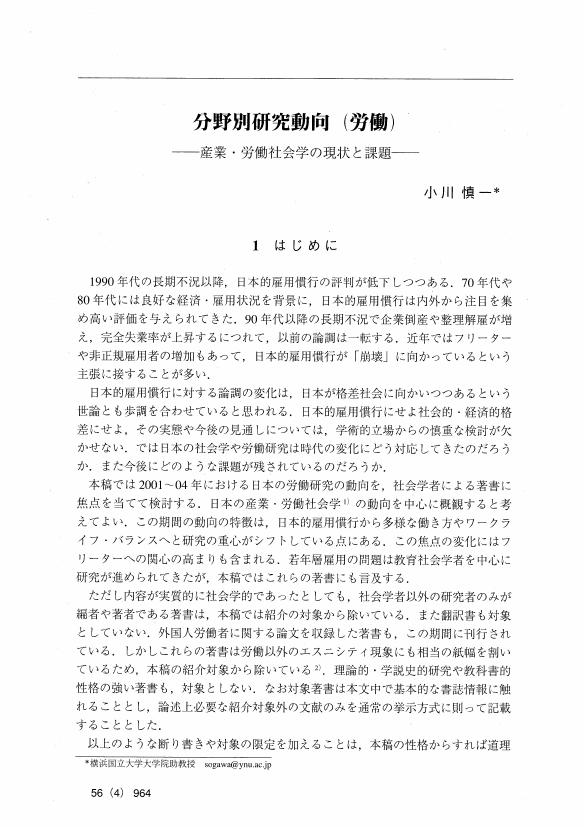- 著者
- 佐久間 政広
- 出版者
- The Japan Sociological Society
- 雑誌
- 社会学評論 (ISSN:00215414)
- 巻号頁・発行日
- vol.65, no.2, pp.303-305, 2014
2 0 0 0 小泉恭子著『メモリースケープ――「あの頃」を呼び起こす音楽』
- 著者
- 羽渕 一代
- 出版者
- The Japan Sociological Society
- 雑誌
- 社会学評論 (ISSN:00215414)
- 巻号頁・発行日
- vol.65, no.2, pp.299-301, 2014
2 0 0 0 OA 牧野智和著『自己啓発の時代――「自己」の文化社会学的探求』
- 著者
- 山田 陽子
- 出版者
- 日本社会学会
- 雑誌
- 社会学評論 (ISSN:00215414)
- 巻号頁・発行日
- vol.63, no.4, pp.630-631, 2013-03-31 (Released:2014-03-31)
2 0 0 0 OA アメリカ社會學界通信 (二)
- 著者
- 尾高 邦雄
- 出版者
- 日本社会学会
- 雑誌
- 社会学評論 (ISSN:00215414)
- 巻号頁・発行日
- vol.1, no.2, pp.108-115, 1950-09-20 (Released:2010-02-05)
2 0 0 0 OA 『高齢化と少子社会』書評リプライ
- 著者
- 金子 勇
- 出版者
- 日本社会学会
- 雑誌
- 社会学評論 (ISSN:00215414)
- 巻号頁・発行日
- vol.54, no.2, pp.204-206, 2003-09-30 (Released:2009-10-19)
- 著者
- 三谷 はるよ
- 出版者
- The Japan Sociological Society
- 雑誌
- 社会学評論 (ISSN:00215414)
- 巻号頁・発行日
- vol.65, no.1, pp.32-46, 2014
本稿の目的は, 「市民活動参加者の脱階層化」命題が成り立つかどうかを検証することである. すなわち, 資源のある人もない人も等しく市民活動に参加するような状況に変化しつつあるのかどうかを検討する. そのために本稿では, 1995年と2010年に実施された全国調査データであるSSM1995とSSP-I2010を用いて, 社会階層と市民活動参加の関連の動向に注目した時点間比較分析を行った.<br>分析結果は以下のとおりである. 第1に, 1995年も2010年も変わらずに, 高学歴の人ほど市民活動に参加する傾向があった. 第2に, 1995年では高収入や管理職の人ほど市民活動に参加する傾向があったが, 2010年ではそのような傾向はなかった. 第3に, 1995年では無職の人は市民活動に参加する傾向があったが, 2010年では逆に参加しない傾向があった. 本稿から, 高学歴層による一貫した市民活動への参加によって教育的階層における「階層化」が持続していたこと, 同時に, 中流以上の層や管理職層, 無職層といった従来の市民活動の中心的な担い手の参加の低下によって, 経済的・職業的階層における消極的な意味での「脱階層化」が生じていたことが明らかになった.
2 0 0 0 OA 科学技術に対する態度におけるDK回答の意味
- 著者
- 日比野 愛子
- 出版者
- 日本社会学会
- 雑誌
- 社会学評論 (ISSN:00215414)
- 巻号頁・発行日
- vol.60, no.4, pp.554-569, 2010-03-31 (Released:2012-03-01)
- 参考文献数
- 21
- 被引用文献数
- 3
本稿では,科学技術に対する態度におけるDK(don't know,「分からない」)回答の意味を質問紙調査から明らかにする.筆者らは2004年に「バイオテクノロジーに関する意識調査」を日本で実施し,541名の成人男女から回答を得た.数量化III類を用いてDK回答の出現パタンを分析した結果,(1)DK回答群が肯定的回答群/否定的回答群の軸から独立して分離するパタン(疎外的DK)と,(2)DK回答群が肯定的回答群/否定的回答群の軸の中に位置づけられるパタン(両義的DK)が見出された.疎外的DKを顕著に示す層は知識量が相対的に少ないという特徴をもっていた.一方,両義的DKの出現は,回答者個人の知識の多寡によらず,科学技術の問題を消費者個人の選好や利用行動に内在化させる質問状況で顕在化していた.2つのDKの意味は,それぞれ,科学技術という主題における主体的かつ二分法的態度をもつ市民像の問題点を示し,社会的意思決定プロセスでの意識調査の位置づけに再考を迫るものである.
2 0 0 0 OA 分野別研究動向 (労働)
2 0 0 0 OA 富永健一著『経済と組織の社会学理論』
- 著者
- 沢田 善太郎
- 出版者
- 日本社会学会
- 雑誌
- 社会学評論 (ISSN:00215414)
- 巻号頁・発行日
- vol.49, no.2, pp.318-324, 1998-09-30 (Released:2009-10-19)
- 参考文献数
- 8
2 0 0 0 OA 小集団論の古典的形態
- 著者
- 阿閉 吉男
- 出版者
- 日本社会学会
- 雑誌
- 社会学評論 (ISSN:00215414)
- 巻号頁・発行日
- vol.11, no.3-4, pp.2-21,184, 1961-05-30 (Released:2009-11-11)
- 参考文献数
- 6
2 0 0 0 OA 戦前の日本社会学
- 著者
- 新明 正道
- 出版者
- 日本社会学会
- 雑誌
- 社会学評論 (ISSN:00215414)
- 巻号頁・発行日
- vol.28, no.2, pp.135-137, 1977-10-30 (Released:2009-10-19)
2 0 0 0 OA 「社会構造」の概念と社会学の視座
- 著者
- 野口 隆
- 出版者
- 日本社会学会
- 雑誌
- 社会学評論 (ISSN:00215414)
- 巻号頁・発行日
- vol.27, no.4, pp.56-62, 1977-03-31 (Released:2009-11-11)
- 参考文献数
- 24
The purpose of this paper is to compare three concepts of social structure which have been designed by A.R. Radcliffe-Brown, Claude Lévi-Strauss, and Georges Gurvitch.Radcliffe-Brown has defined social structure as “the network of actually existing relations”, taking an empirical position to see social reality on its surface. In contrast to this view, Lévi-Strauss has conceived of structure as a model, the formal property of which can be compared independently of its elements ; that is, he attempts to analyse structure at deeper level than empirical reality. However, these views run to extremes ; the former being too empirical and the latter too abstruct transcending the socio-cultural level.The real sociological standpoint should be that of empiricoideal or concrete-abstract as Gurvitch has assumed. Critisizing that Radcliffe-Brown's position is superficial and that of Lévi-Strauss is systematic but not holistic, Gurvitch emphasizes the meaning of social whole itself besides the interaction of social elements. And he attempts to analyse the social reality in a dynamic way, saying that the essence must be seeked in its movement and depth.Accepting Gurvitch's basic stand, I suggests in these paper that structure must be conceived as a totality of both culturally and socially constructed structures.
2 0 0 0 OA 社会構造と社会類型
- 著者
- 野口 隆
- 出版者
- 日本社会学会
- 雑誌
- 社会学評論 (ISSN:00215414)
- 巻号頁・発行日
- vol.9, no.2, pp.67-84,136, 1958-12-30 (Released:2009-11-11)
- 参考文献数
- 57
Most of sociologists in establishing social types applied chiefly the general scheme of social relations. For example, Tonnies' “Gemeinschaft” and “Gesellschaft, ” Durkheim's “solidalite mecanique” and “solidalite organique, ” Gierke's “Herrschaft” and “Genossenschaft” etc.Although on may find sociologists' tentatives done from the point of view of social structure, they seized only its partial structure and regarded it as its whale structure or its elemental structure dogmatically. Consequently, it is in urgent need for us to establish social types based on the concept of social structure made precise sociologically in the strict sense of the term. This paper is a contribution to make precise the concept of social structure in relation to social types. According to Radcliffe-Brown, the social structure is in the first place the network of social relations of person to person, and is in the second place the differentiation of individuals and of classes by their social role or the differential social positions. Definitions of Redfield, Linton and Parsons are nearly parallel to the definition of Radcliffe-Brown. In short, the concept of social structure by these Anglo-Saxson savants is presented as the double construction that puts the notion of position of role “made on the basis of an interest in ego as a composite of action units relavant to various collectivities” on the micro-structure notion of social relations made “on the basis of interest in ego as an action system per us.” However, I centered on the concept of role that is “the point of contact between the system of action of the individual actor and the social system, ” though the composite of micro-social elements enters in the explication of social structure concept. The concept of role explicates the social structure directly in relation to the microsociety. And then the role defined by these savants supposed the system and could not be explained withont relation to the cultural pattern on the institution. This fact led them to the emphasis on the stability of social structure. Of course, Radchiffe-Brown and Parsons paid attention ot its changing phase. Radchiffe-Brown set up “actual structure” in opposition to “structural form”, and parsons said if theory is good theory, there is no reason whatever to belive that it will not be equally applicable to problems of change and to those of process within a stabilized system. But neither of them could clarify the positive sense of social change. It was only Merton that succeeded to throw light upon the positive meaning of change in social structure, to a certain extent, by the application of notions of “dysfunction” and “latent function.” But, the social structure is dynamic in itself and is a perpetual movement of structuration and distructuration. If so, the social structure will have no need, says Gurvitch, of a special functional analysis, entia non sunt multiplicanda. Gurvitch's definition of social structure is presented in “Determinismes Sociaux et Liberte Humaine” and La Vocation Actuelle de la Sociologie (2ed.). Ultimately, he considers the social structure as the dialectic of act and its works. Such elemental terms by which we can explain the social structure as multiple hierarchies, equiliblium, collective consciousness, culturall armature and movement of structuration -distructuration- restructuration will be derived from above.
2 0 0 0 OA 西村勝彦著 理論社会学の根本問題
- 著者
- 鈴木 幸寿
- 出版者
- 日本社会学会
- 雑誌
- 社会学評論 (ISSN:00215414)
- 巻号頁・発行日
- vol.7, no.2, pp.83-85, 1957-02-25 (Released:2009-11-11)
2 0 0 0 OA 「社会学研究」
- 著者
- 東北社会学研究会
- 出版者
- 日本社会学会
- 雑誌
- 社会学評論 (ISSN:00215414)
- 巻号頁・発行日
- vol.6, no.1, pp.134-137, 1955-07-30 (Released:2009-11-11)
2 0 0 0 OA 相互作用におけるレイベリングの影響
- 著者
- 宝月 誠
- 出版者
- 日本社会学会
- 雑誌
- 社会学評論 (ISSN:00215414)
- 巻号頁・発行日
- vol.29, no.2, pp.28-40, 1978-09-30 (Released:2010-02-05)
- 参考文献数
- 29
Labelling-effect on a deviant has been discussed in terms of negative reaction, an exclusion or avoidance which causes social deprivations to imputed labellee. My process approach focusing on Identity Problem would seem to possess a merit for finding out labellee's adaptive process to labelling. When labellee dose not yet reach the deviant career in which he defines himself as a deviant, he suffers from some embarrassment because of discrepancy between self-identity and social-identity. I call it Identity Problem. There are some strategies for him to adapt to it-avowal, acquiescence, modification, flight, declaration of non-conformist, exchange for another deviant identity. If he wants to modify social identity as a deviant, he must keep his hands clean in his every activities not to be unjustly and make every endeavor to call back to his credibility through a certain line of action-say, achievement of work or social services. At the same time, it is important that there is a certain group which supports his efforts and gives him normal identity, because it is difficult for labellee to maintain his motivation for a long time under the condition in which others continue to identify his real trait as a deviant.Without, such a support, he gives up his endeavors and try to use another adaptation. He might fall into a deviant avowal. Paradoxically, the stronger he wants to modify his deviant identity, the more often he becomes a deviant avowal, since he is forced to do something to liquidate his unattainable desire. The technique he often uses is to do self-degradation by committing some deviant behavior again. The trigger of this self-degradation would be easily pulled when he defines other's attitude unchangeable ; lacks of his tolerance of embarrassment ; and happens to be caught-in precipitating factors-say, an insult by significant others or a temptation by deviant group.
2 0 0 0 OA コミュニケーションによる自己組織化
- 著者
- 正村 俊之
- 出版者
- 日本社会学会
- 雑誌
- 社会学評論 (ISSN:00215414)
- 巻号頁・発行日
- vol.40, no.2, pp.121-136,249, 1989-09-30 (Released:2009-11-11)
- 参考文献数
- 17
近年、社会の自己組織化に対する関心がにわかに高まってきた。このような自己組織化に対する関心の高まりは、現代社会そのものがきわめて自己組織的になっていることを背景にしている。本稿のねらいは、現代社会の自己組織性をコミュニケーション論的な視覚から分析することにある。そこでまず、伝統的なコミュニケーション論を批判的に検討し、メッセージの意味構成のあり方に着目したコミュニケーション類型を呈示する。次に、自己組織化には、(1)反省的コミュニケーションによる自己組織化のほかに、(2)原初的コミュニケーションによる自己組織化という別の様式があることを示し、それがどのような特性をもつのかを明らかにする。そして最後に、原初的コミュニケーションが現代社会の自己組織化に果たす役割について述べる。
- 著者
- 島薗 進
- 出版者
- 日本社会学会
- 雑誌
- 社会学評論 (ISSN:00215414)
- 巻号頁・発行日
- vol.54, no.4, pp.431-448, 2004-03-31
バウマンやベックのように, 「ポストモダン」や「第2の近代」の特徴を「個人化」という概念を手がかりとして捉えようとする戦略は有効であるが, その場合, 新たな宗教性が活性化したり, 宗教が新たに公共領域への関与を強めるといった現象をどのように理解するかという課題が生じる.先進国におけるスピリチュアリティの興隆の現象を, (1) 死生のケアに関わるスピリチュアリティの興隆と, (2) セルフヘルプ的なネットワークの拡充から考察する.1980年代以降の日本では, 死生の危機に直面する人々の精神的支え合いのネットワークや, 嗜癖者や障害者同士が相互扶助的なネットワークを通してスピリチュアルな体験を得て元気づけられていくセルフヘルプ運動が目立った.これらは個人化した社会に住む「個人の宗教化」の傾向を示すものだが, 他方, 視野を世界に広げると, 普遍的な連帯の構築をよびかける救済宗教も「原理主義」や「カルト」などの形をとって発展してきている.社会の個人化に対して, 宗教的共同性を正面から掲げて, 公共空間に声をあげていこうとするものである.だが, これほど鮮明ではないとしても, 個人的なスピリチュアリティを掲げる勢力も, 環境問題, 生命倫理問題など公共的な論題に声をあげようとしている.社会の個人化は個人の宗教化を生み, 公共空間への新たな宗教性の参与をも招いている.
2 0 0 0 OA 牟田和恵編『家族を超える社会学――新たな生の基盤を求めて』
- 著者
- 江原 由美子
- 出版者
- 日本社会学会
- 雑誌
- 社会学評論 (ISSN:00215414)
- 巻号頁・発行日
- vol.61, no.2, pp.222-223, 2010-09-30 (Released:2012-03-01)









